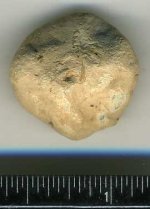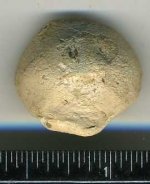Erik in NJ
Silver Member
- Oct 4, 2010
- 4,037
- 3,043
- 🥇 Banner finds
- 1
- Detector(s) used
- Minelab Explorer SE Pro & CTX-3030
- Primary Interest:
- Metal Detecting
Found this today in NJ in the side yard of a church that dates back to the mid 1600's. I have permission from the Pastor as there will be some construction here in the near future. I spent about 4 hours there beore my vacation and basically got skunked. Frustrating to find nothing in a field with so much potential! I'm surmising that this area was once wooded or it has been filled. Either way it seems to be pretty much devoid of targets.
Perhaps the most interesting thing found was this item. It's very heavy and by the heavy white patina I'm guessing a lead musket ball. It's no longer round, but measures approx. 3/4" x 1/2". This area was inhabitted by Dutch, Indians, and saw Washington's troops march near by. The patina is very solid and thick. Best 3D shape description is it's kinda like the shape of a "flying saucer" though it's not terribly symmetrical.
Thanks for any help!
Perhaps the most interesting thing found was this item. It's very heavy and by the heavy white patina I'm guessing a lead musket ball. It's no longer round, but measures approx. 3/4" x 1/2". This area was inhabitted by Dutch, Indians, and saw Washington's troops march near by. The patina is very solid and thick. Best 3D shape description is it's kinda like the shape of a "flying saucer" though it's not terribly symmetrical.
Thanks for any help!




 for the quick reply! Any idea on caliber or whether it was American or Brit? Any way to get an approx timeframe? Thanks again!!
for the quick reply! Any idea on caliber or whether it was American or Brit? Any way to get an approx timeframe? Thanks again!!



